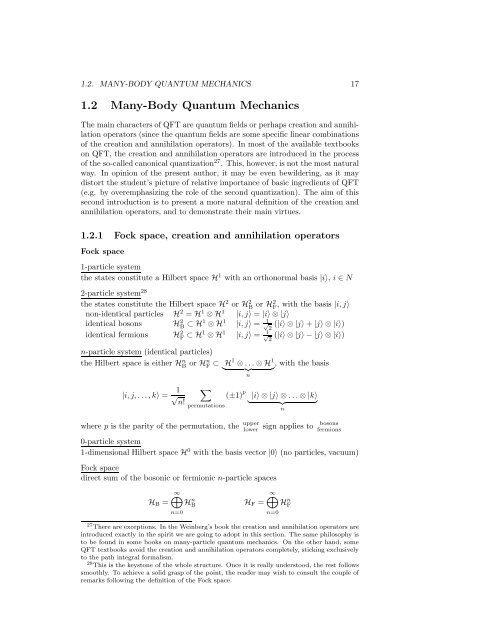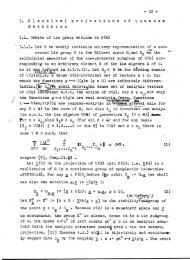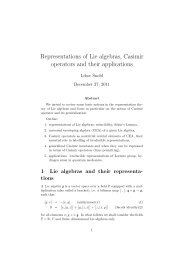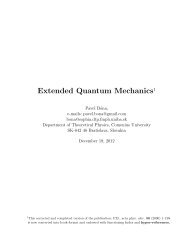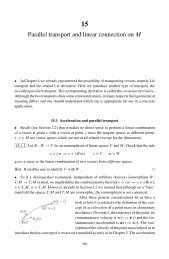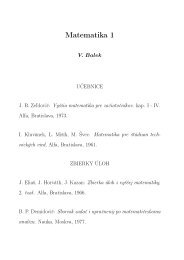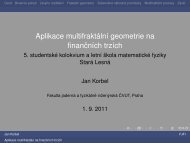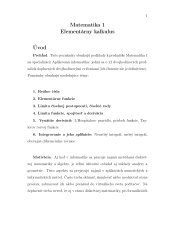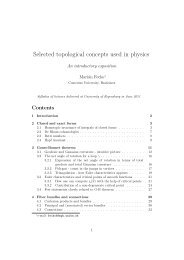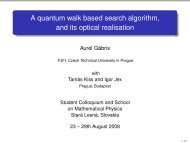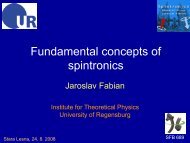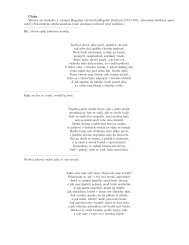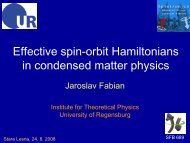Quantum Field Theory I
Quantum Field Theory I
Quantum Field Theory I
You also want an ePaper? Increase the reach of your titles
YUMPU automatically turns print PDFs into web optimized ePapers that Google loves.
1.2. MANY-BODY QUANTUM MECHANICS 17<br />
1.2 Many-Body <strong>Quantum</strong> Mechanics<br />
The main charactersof QFT are quantum fields or perhaps creation and annihilation<br />
operators (since the quantum fields are some specific linear combinations<br />
of the creation and annihilation operators). In most of the available textbooks<br />
on QFT, the creation and annihilation operators are introduced in the process<br />
of the so-calledcanonical quantization 27 . This, however, is not the most natural<br />
way. In opinion of the present author, it may be even bewildering, as it may<br />
distort the student’s picture of relative importance of basic ingredients of QFT<br />
(e.g. by overemphasizing the role of the second quantization). The aim of this<br />
second introduction is to present a more natural definition of the creation and<br />
annihilation operators, and to demonstrate their main virtues.<br />
1.2.1 Fock space, creation and annihilation operators<br />
Fock space<br />
1-particle system<br />
the states constitute a Hilbert space H 1 with an orthonormal basis |i〉, i ∈ N<br />
2-particle system 28<br />
the states constitute the Hilbert space H 2 or HB 2 or H2 F , with the basis |i,j〉<br />
non-identical particles H 2 = H 1 ⊗H 1 |i,j〉 = |i〉⊗|j〉<br />
identical bosons HB 2 ⊂ H1 ⊗H 1 |i,j〉 = √ 1 2<br />
(|i〉⊗|j〉+|j〉⊗|i〉)<br />
identical fermions HF 2 ⊂ H1 ⊗H 1 |i,j〉 = √ 1 2<br />
(|i〉⊗|j〉−|j〉⊗|i〉)<br />
n-particle system (identical particles)<br />
the Hilbert space is either HB n or Hn F ⊂ H1 ⊗...⊗H<br />
} {{ 1 , with the basis<br />
}<br />
n<br />
|i,j,...,k〉 = 1 √<br />
n!<br />
∑<br />
permutations<br />
where p is the parity of the permutation, the upper<br />
lower<br />
(±1) p |i〉⊗|j〉⊗...⊗|k〉<br />
} {{ }<br />
n<br />
sign applies to<br />
bosons<br />
fermions<br />
0-particle system<br />
1-dimensional Hilbert space H 0 with the basis vector |0〉 (no particles, vacuum)<br />
Fock space<br />
direct sum of the bosonic or fermionic n-particle spaces<br />
∞⊕<br />
∞⊕<br />
H B = HB n H F =<br />
n=0<br />
27 There are exceptions. In the Weinberg’s book the creation and annihilation operators are<br />
introduced exactly in the spirit we are going to adopt in this section. The same philosophy is<br />
to be found in some books on many-particle quantum mechanics. On the other hand, some<br />
QFT textbooks avoid the creation and annihilation operators completely, sticking exclusively<br />
to the path integral formalism.<br />
28 This is the keystone of the whole structure. Once it is really understood, the rest follows<br />
smoothly. To achieve a solid grasp of the point, the reader may wish to consult the couple of<br />
remarks following the definition of the Fock space.<br />
n=0<br />
H n F


